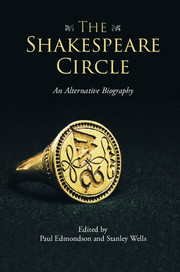Closing remarks
Published online by Cambridge University Press: 05 November 2015
Summary
Imagine standing on the edge of a lake and throwing a handful of pebbles into it. You are faced with a host of concentric circles which overlap, intersect, embrace, reach out in different directions, but which hold within themselves a sense of their own boundaries. The contributions we have gathered together for The Shakespeare Circle remind us of many different kinds of circles that emanate from the centre of Shakespeare's life and help to shape its peripheries. There are circles of familial influence and responsibility, neighbourly and professional intentions, circles of reputation among patrons, readers, critics, printers and publishers; circles of collaboration with other playwrights, actors, theatrical entrepreneurs and business investors. They overlap like Venn diagrams, leaving ample space for mutually including as well as excluding points of view.
Looking back over the chapters in this volume we are struck by a number of recurring themes, not least the intimacy of daily life as it was lived out among the neighbourhoods Shakespeare knew in both Warwickshire and London. Members of the Hathaway family from Shottery involved themselves in the civic life of Stratford and lived close to New Place on Chapel Street. New Place itself seems to have been the nexus for various members of the Shakespeare family, of which Shakespeare himself became the patriarch and chief bread-winner from the time of his father's death in 1601. This family home was among Shakespeare's primary assets and, along with his other significant local investments, shows how he ploughed money earned in London back into his hometown. The lack of privacy within individual houses was reflected in the town's social circles in which gossip thrived. In July 1613, Susanna Hall had no choice but to sue John Lane for defamation of character when he accused her of committing adultery and having a venereal discharge (or ‘running of the reins’). The rumour would have spread through the town as wildly as the fire that had destroyed the Globe a month earlier. It was difficult to keep anything a secret both in the Stratford of Shakespeare's time and among the close-knit theatrical circles of actors who worked together, like a brotherhood, for many years.
- Type
- Chapter
- Information
- The Shakespeare CircleAn Alternative Biography, pp. 329 - 334Publisher: Cambridge University PressPrint publication year: 2015
References
- 1
- Cited by

